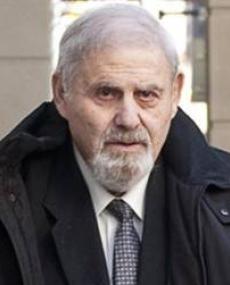
Aubrey Levin was born in Johannesburg on 18 December 1938 to Jewish parents. Despite the National Party’santi-Semitic exclusion of Jews from its ranks, Levin’s family were ardent supporters of the Party’s ideals. Levin studied medicine at the University of Pretoria where he was awarded a scholarship by the South African Defence Force (SADF). Levin was vocally right-wing and gained a reputation amongst his peers for sabotaging meetings advocating for communism or multiracialism. While Levin only formally became a qualified psychiatrist in 1969, he entered the historical record a year earlier when he wrote a letter, asking to appear before the Select Committee on the Immorality Amendment Act to illustrate his suggested ‘cure’ for homosexuality.
His proposed ‘treatment’ was to use electro-shock therapy; a method he was theoretically introduced to while working at Tara Psychiatric Hospital in Johannesburg as a student. This broadly involved ‘curing’ a patient by showing them pornographic images of same-sex people and simultaneously shocking them with an electric current. The idea behind this was that the person would associate that stimulus (sexual attraction to the same sex) with pain and ultimately not want to engage in that activity.
While Levin was never called before the aforementioned committee, he was able to put his supposed cure into action when he entered the SADF as a colonel and military psychiatrist in 1969. Levin worked and headed the medical team in Ward 22 of One Military Hospital in Pretoria. Apartheid South Africa is known for its use of psychiatry to discredit activists by pathologizing or institutionalising them, a practice that extended to the army’s treatment of its conscripts. Ward 22 was infamous as the ‘loony bin’ for soldiers who suffered psychotic breakdowns as a result of war. In reality however, most of the patients in Ward 22 had never been in combat. Most of the patients were conscientious objectors, drug users, homosexual or in some way deviant from the expectations of the SADF. It was here that Levin practised what has come to be known as The Aversion Project, where he subjected White gay and lesbian individuals from the SADF to electro-shock therapy. However, his ‘treatments’ extended not just to homosexual conscripts, but also to conscientious objectors and drug users. Levin has a history of drug abhorrence, with his doctoral thesis being a damning analysis of the use of marijuana by White men in the SADF.
His project expanded when, in 1970, he oversaw the building of Greefswald, a farm just outside of Limpopo. The farm acted as an experiment where many young men were subjected to forced labour and physical torture in a bid to “peel [them] like an onion”(Popluck, 2015). This meant that those who were not cured of their deviance while under Levin’s care in Ward 22 were sent on to Greefswald. Here, patients were subjected to a rogue version of military training; they were forced to march for hours through the bush, build barracks, shoot wildlife, and were deprived of food and sleep. They were not allowed any contact with their families, who believed they were still being treated at Ward 22.
Upon leaving the military in 1975, Levin worked in both Bloemfontein and Grahamstown, eventually being posted as the Director of Mental Health in the Department of Health Services and Welfare in the Eastern Cape. He held various academic posts during this time up until 1995 when he, his wife and four children fled South Africa and relocated to Canada.
Citing the increase of violent crime as the reason behind his sudden departure, the historical record suggests instead that it was the formation of the Truth and Reconciliation Commission that prompted the Levins to leave the country. This is supported by evidence from his successor who took over the directorship at the Department of Health Services and Welfare, who explained that he had to post Levin’s things to him in Canada because he left in such a hurry that he was not able to pack up his office. However, while Levin was called to testify in front of the Commission, he refused and threatened legal action. In the final report, Levin is mentioned only as ‘The Colonel’ and is erroneously dubbed a ‘psychologist’ (Van Zyl, de Gruchy, Lapinsky, Lewin & Reid, 19990).
Levin’s Apartheid past remained relatively hidden during his years in Canada. Here, he was able to gain a professorship and worked as a forensic psychiatrist for the state. He treated patients who were required to undergo psychiatric treatment by the Canadian justice system. During this time, any mention of his past was quashed with legal threats and he managed to escape disciplinary action in South Africa and gain Canadian Citizenship.
In 2010, a male patient came forward with recorded footage of Levin sexually assaulting him and Levin’s medical licence was suspended after approximately 30 other victims came forward with allegations of abuse. Levin was put on trial and found guilty by a jury on 3 counts of sexual assault on 28 January 2013, all involving male patients. He was sentenced to 5 years in prison but released on parole 18 months into his sentence after it was determined that he was sickly and not a flight risk. His wife, Erica Levin, was convicted of obstructing the ends of justice when she attempted to bribe a juror in her husband’s case.
Levin retained his Canadian citizenship but was not allowed to make contact with any of his victims and—ironically—had to attend psychiatric counselling by the state. No efforts till then had been made by the South African government to extradite Levin back to South Africa to face charges for his human rights abuses perpetrated while serving in the SADF.